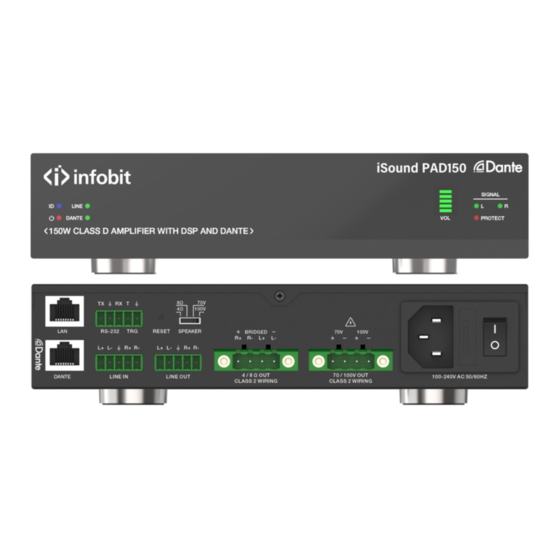
Subscribe to Our Youtube Channel
Summary of Contents for infobit iSound PAD150
- Page 1 PAD150 150W Class D Amplifier with DSP and Dante User Manual V1.0 www.infobitav.com info@infobitav.com...
-
Page 2: Table Of Contents
Thank you for purchasing this product For optimum performance and safety, please read these instructions carefully before connecting, operating or adjusting this product. Please keep this manual for future reference. Surge protection device recommended This product contains sensitive electrical components that may be damaged by electrical spikes, surges, electric shock, lighting strikes, etc. -
Page 3: Introduction
1. Introduction This product is a high-performace 150W Class D amplifier, with Hi-Z (70V/100V) or Lo-Z (4Ω/ 8Ω) optional. It supports Dante 2CH digital audio and Line balanced analog level inputs and outputs. With built-in audio DSP processor, the amplifier features stable output frequency response, excellent signal-to-noise ratio, and ultra-low distortion rate. -
Page 4: Specifications
4. Specifications Technical 1x Dante Network audio input Input 1x LINE balanced stereo 0dBu/10kΩ input 1x Dante Network audio output 1x Stereo or constant voltage 70V/100V speaker output Output 1x LINE balanced stereo output Input Sensitivity Full power@0.775V (0dBu) DC power supply: 2x 75W@4Ω/8Ω; 1x 150W@8Ω; Output Power 1x 150W@70V/100V Maximum Voltage Gain 27-30dB SE/39-42dB BTL... -
Page 5: Operation Controls And Functions
Mechanical Housing Front panel: Aluminum; Rear case: Metal Enclosure Color Black Dimensions 240mm [W]×210mm [D]×44mm [H] Weight 1.88Kg DC Input: AC100 - 240V 50/60Hz Power Supply Power Consumption 150W (Max) Operating Temperature 0°C ~ 40°C / 32°F ~ 104°F Storage Temperature -20°C ~ 60°C / -4°F ~ 140°F Relative Humidity 20%~90% RH (non-condensing) -
Page 6: Rear Panel
5.2 Rear Panel TX RX T 100V RS-232 RESET SPEAKER BRIDGED 70V 100V 4 / 8 Ω OUT 70 / 100V OUT DANTE LINE IN LINE OUT 100-240V AC 50/60HZ CLASS 2 WIRING CLASS 2 WIRING Name Function Description Connect to a PC for Web access. The default IP address is LAN port 192.168.0.200. -
Page 7: Dante Web Gui User Guide
6. Dante Web GUI User Guide There is a built-in Dante Web GUI for the amplifier. The operation method is shown as below: Step 1: Connect the amplifier and PC to the same Ethernet Switch with two Network cables. Step 2: Set the Network connection setting of PC to be “Obtain an IP address Automatically”. 169 168 1 30 Step 3: Open the Dante Controller software on the PC, and find the Dante device on the Routing page, as shown in the figure below. - Page 8 Step 4: Click the Device Info tab to check the IP address of the Dante device. Step 5: Input the IP address of Dante device into your browser on the PC to enter the login interface of the Dante Web GUI. The default usernames and passwords are as below: Username User...
- Page 9 ■ Information Page The Information page provides basic information about the model name, software version and IP information. ■ Preset Page You can set up to 5 preset scenes on the Preset page. ① Preset Name: You can name the preset scene. (Chinese name is not supported.) ②...
- Page 10 Source Select ① Line In: Click “Line In” to select the LINE IN port as the signal input channel for audio output. ② Dante In: Click “Dante In” to select the DANTE port as the signal input channel for audio output.
- Page 11 ■ Network Page Network Configuration: You can set the IP Mode (DHCP/Static), IP Address, Subnet Mask, Gateway, Telnet Port and Domain Name. Note: The Domain Name “HDP-PA150D.local” can be used to login the Web GUI. After setting up, click “Save” to take effect, or you can click “Cancel” to cancel the setting. ■...
-
Page 12: Rs-232 Control Command
7. RS-232 Control Command The product also supports RS-232 command control. Connect the RS-232 port of the product to a PC with a 3-pin phoenix connector cable and an RS-232 to USB cable. The connection method is as follows. Ground 3-pin Phoenix Connector RS-232 RS-232 to USB cable... - Page 13 Function Description Example Feedback Command Code Default Setting r fw version MCU 1.1.0 Web 1.1.0 r fw version Get Firmware version Power on System Initializing... s power on Power on the device s power on Initialization Finished! MCU 1.1.0 Web 1.1.0 Power off s power off Power off the device...
- Page 14 Function Description Example Feedback Command Code Default Setting Increase input:x volume Increase input line s input x vol+ s input 1 vol+ volume: 52 x=[0-2] 0:All, 1:Line, 2:Dante Decrease input:x volume Decrease input line s input 1 vol- s input x vol- volume: 50 x=[0-2] 0:All, 1:Line, 2:Dante s input x mute...
- Page 15 Command Code Function Description Example Feedback Default Setting Get output:x mix mode Output speaker mix: r output 1 mix r output x mix x=[0-3] 0:All, 1:Speaker, 2:Line, Stereo 3:Dante Set output:x delay:y s output 1 delay 50 Set output speaker delay: x=[0-3] 0:All, 1:Speaker, 2:Line, s output x delay y 50ms...
- Page 16 Command Code Function Description Example Feedback Default Setting Get network MAC address MAC: 6C:DF:FB:0C:B3:8E r mac addr r mac addr Set network IP mode to static IP IP mode: Static or DHCP (Please use "s net reboot!" s ip mode x s ip mode 0 x=[0-1] command or repower...
-
Page 17: Connection Diagram
Function Description Example Feedback Command Code Default Setting Password Setting Set admin login password s admin password s admin password admin password: 1234 1234 (x=[16 characters max]) 1234 Get admin login password r admin password admin password: 1234 r admin password Set user login password s user password user password: 1234...


Need help?
Do you have a question about the iSound PAD150 and is the answer not in the manual?
Questions and answers